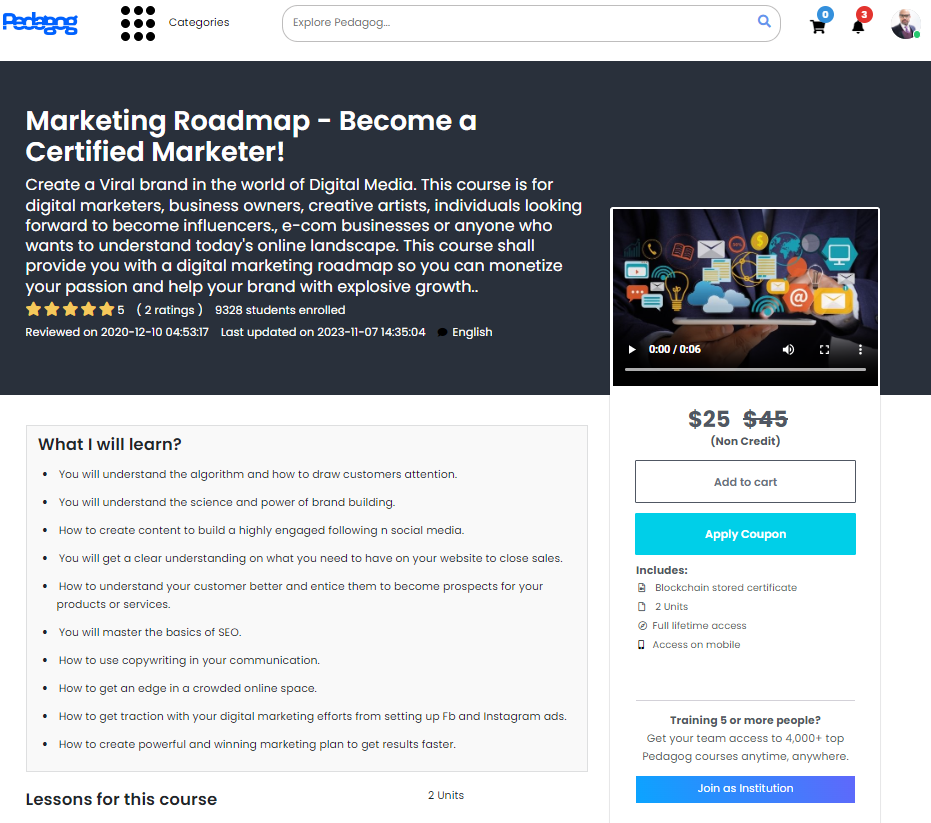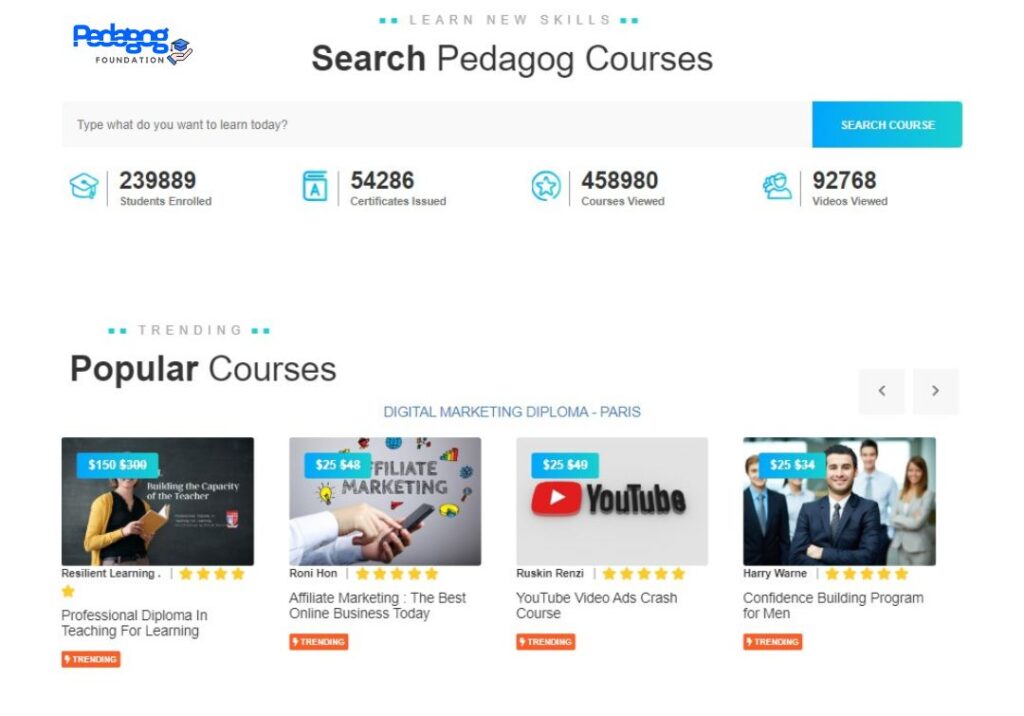One industry that has grown significantly recently is the creation and sale of online courses. The worldwide eLearning market is predicted to increase to $375 billion by 2025, reflecting the enormous demand for genuine and reliable courses.
Consider the course: Marketing Roadmap – Become a certified Marketer on Pedagog, that has nearly 10K students enrolled. It is priced at $25. Even if 60% of the enrolled students paid the course’s current price (some receive free coupons), the course still has made about $0.14 million, and the instructor around $0.13 million. That’s fantastic! If you can produce this much with just one day’s worth of video content. Isn’t it? Additionally, it’s just a passive earning.

This is but one illustration. In actuality, there is a sizable market for offering courses, and consumers are eager to find high-quality courses to further their skills, careers and hence their personal growth.
You will learn how to offer courses online and earn money from scratch by following the guidelines in this article. If you are a newbie and don’t know where to start, this practical tutorial is for you. Let’s first examine the reasons why selling online courses might be a lucrative business for you.
Creating Online Courses: A Massive Business Sector
Ask the pioneers of online courses and you will hear countless tales of how they quit their full-time jobs to create online courses that enabled them to generate incredible income—all of it passive.
Instructors and learning centres like Dr. Paul Charles, Dr, Edward Roy Krishnan, Prof Joel Farnworth, Tony Robbins, John Course, Learning Guru, Learning Power, Jonathan Walter, Catherine Zetta, Chris Bandwith on Pedagog made a whopping income just in the first month of publishing their courses on Pedagog. Hence, making money online by selling courses is a very successful business model currently and definitely the time to come. The recent researches confirms that the rise of online education has revolutionized the education sector.
Online education has gained popularity due to its accessibility, flexibility, and affordability not only for the young learners but specially for adult learners who may have work or family obligations, including the corporates and organisations to train their workforce. Students not only save money on commuting costs, textbooks, and other supplies associated with traditional learning but they are able to enroll in courses around the world, expanding their knowledge and skills beyond their geographical location.
Hence, the market for developing and offering online courses is expanding. The best aspect is that earning money in this manner is a viable business strategy generating a passive income stream. What more can we ask for?

Step-by-step guide to make money through Course Selling:
The detailed instructions that follow will walk you through the process of creating and launching a course, as well as how to get your first payment.
Step 1: Create an online course
The content is the core product and it has to be worthwhile and useful. Start by identifying a specific niche in your field. Define a problem that your target audience is having and What issue will your course address.
Assume you work in marketing and would like to develop a social media marketing course. Begin with searching for already-existing courses in this field, ideally the best-sellers, to identify what’s lacking. Research is necessary to identify a problem in your field. Go to marketplaces to find out what content your competitors are selling, spot any gaps, check their course reviews to know your target audience feedback.
With this knowledge you’ve gained through your research, you can improve the course and provide your students even more. A little more in-depth research will help you understand the Trending topics and problems in your area, Google trends and Subject matter experts.
Now that you have finalised your topic, create your course outline, write a script, find relevant images, recording, editing etc. Even the resources offered by platforms that sell courses can be used to assist in the construction of courses. The following are the other elements of creating a course that must be considered at this stage:
- Ensure the demand for the course idea that you have finalised.
- To make your course engaging and beneficial, identify your target audience and learn about their characteristics.
- Emphasise the advantages of your course when crafting clear and captivating learning objectives.
- The course objective, content, and learning outcomes must align. Make sure there’s no deviation of any kind. Check for any kind of discrepancy.
- Make use of the right resources and tools while creating courses.
Step 2: Selecting the Best course selling platform
With the help of a course selling platform, you can easily host, deliver, and market your course to the target learners. It also takes care of all the administrative tasks like course creation, marketing, and payment processing. Some top course selling platforms are; Pedagog, Udemy, Thinkific, EdEx etc.
Make an informed decision about choosing a platform through the following:
- Take your time to learn how to navigate a sophisticated platform for a highly personalised marketplace website?
- Learn to use the platform’s text and images to put together basic courses or you can even construct interesting interactive courses.
- If you already have a website, integrate it with your marketplace for a streamlined brand experience.
- You may also need an access to sales funnel tools in order to obtain more leads and prospects.
- Most importantly, the course instructor revenue being offered by the platform.

Step 3: Promoting your course
Merely listing your course on a selling platform won’t generate any sales. You must vigorously market it. Here are some of the finest strategies to promote your course so that you can begin making money from it right away.
Create one If you don’t have a blog, perhaps with the help of WordPress. It strengthens your reputation and helps you obtain tonnes of targeted visitors.
After your website is operational, begin posting articles with SEO optimisation that are relevant to the subject of your course. Google will soon start sending organic visitors to your blog. Every person who sees your post has the potential to become a student, so once you start receiving visits, marketing your course will become easy.
The most crucial thing to remember is that you must consistently post and offer incredibly helpful content.

Create a mailing list
Since email marketing is non-intrusive and highly personalised, it offers the highest return on investment (ROI). The largest source of sales is your email list. In order to establish communication and a relationship, you must gather the email addresses of your users. You may accomplish this in a variety of ways using social media, your blog, and other platforms.
One of the easiest approaches is to offer your course free of cost for a limited-time. It will generate excitement, and word-of-mouth advertising will be quite beneficial. Once you get subscribers for the free course, offer the upgraded version of your course to those subscribers. You will be amazed to witness the sales generated by a single email. That’s how powerful your mailing list is.
Leverage social media
With over 3.81 billion users globally, social media is the largest driver of traffic creation. Social networking services like Facebook, Instagram, Twitter, and LinkedIn are great ways to establish a connection with your target audience. To start, just create accounts, share your most recent blog posts or make frequent posts, and interact with your followers. Using social media ads to direct target audience to your course is also a great idea. You may run Facebook and Instagram ads to promote your course for as little as $5 per day.
Step 4: Automate
Once you begin generating revenue, you will most likely consider making more courses in order to expand your clientele and increase revenue. Thus, it is imperative to automate the promotion and sales of courses so that you can concentrate on what really matters i.e., creating new courses. You can set to execute automatically on certain platforms.
Conclusion
If you are successful in reaching your target audience and producing high-quality content, Creating and selling online courses can be very profitable. Additionally, with the latest platforms such as Pedagog, you can publish your course and begin earning money straight away. The Instructors Dashboard offers you numerous tools absolutely free of cost. Above all, you get around 90% of your course sales revenue which is highest in the market.
So, what are you waiting for? Get set and go! Signup for an Instructor’s account on Pedagog
Pedagog Support: Mail [email protected]


